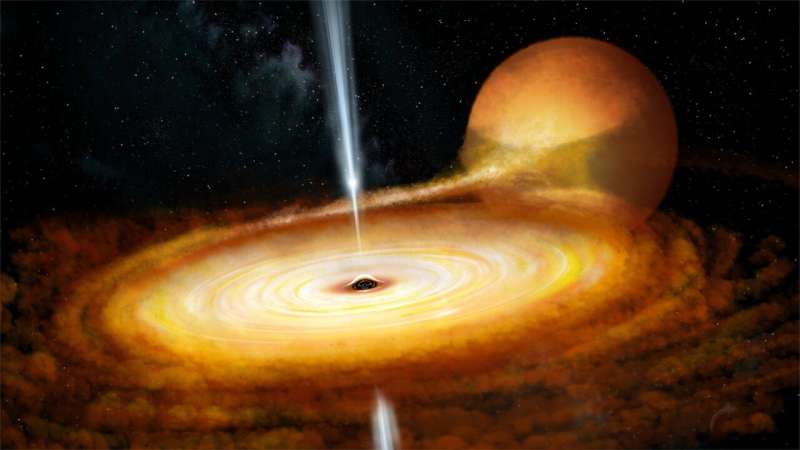January 14, 2020 report
AstroSat observations unveil properties of black hole binary MAXI J1820+070

Tomasz Nowakowski
astronomy writer

Simultaneous spectral and temporal observations of the newly detected black hole X-ray binary (BHXB) MAXI J1820+070 using the AstroSat spacecraft, have delivered more insights into the properties of this source. Results of the study, presented in a paper published January 6 on arXiv.org, could be helpful in improving our understanding of black hole binaries in general.
X-ray binaries consist of a normal star or a white dwarf transferring mass onto a compact neutron star or a black hole (BHXB). During outbursts, BHXBs showcase random short-term variability in their flux, and such behavior is a subject of numerous studies aiming to disentangle their origin.
Observations have shown that the X-ray variability in BHXBs is well represented by their power density spectra (PDS). In most cases, these spectra are characterized by broadband continuum noise-like features, however, they sometimes exhibit narrow peak features called quasi-periodic oscillations (QPOs). The exact mechanism of such oscillations is still not fully understood and requires further studies.
Located some 11,300 light years away, MAXI J1820+070 is a BHXB first detected in March 2018 as a black hole X-ray transient. Its outburst cycle was found to last for almost a year, showcasing rapid, frequent, alternating transitions between hard and soft spectral states. Indian astronomers, led by Sneha Prakash Mudambi of Christ University in Bangalore, India, decided to take a closer look at this binary, hoping to get more detailed information about its properties.
"We report the results of spectro-timing analysis of MAXI J1820+070 as observed by SXT and LAXPC onboard AstroSat for the first time. We have analyzed ∼ 93 ks of observed data corresponding to 15 individual satellite orbits," the astronomers wrote in the paper.
According to the study, the spectrum of MAXI J1820+070 was found to be dominated by a thermal Comptonization component along with disk emission and a reflection component. Spectral index was measured to be approximately 1.61, which suggests that the source was in the hard spectral state with a cool disk (disk temperature of about 0.22 keV) truncated at a large distance (around 526 kilometers).
Furthermore, the study detected a quasi-periodic oscillation with the centroid frequency at 47.7 mHz. The astronomers noted that the PDS of MAXI J1820+070, besides this QPO, could be modeled with four other components: a weak oscillation at 109.4 mHz and three broadened noise humps spread over 0.004 to 30 Hz.
"The spectrum shows a prominent QPO at 47.7 mHz and three broadened noise humps, which can be represented by Lorentzians. There is also a weak feature at 109.4 mHz," the paper reads.
Summing up the results, the researchers emphasized AstroSat's importance for spectral and temporal studies of X-ray binaries and other sources. They added that the satellite has the capability of measuring the broadband time-averaged spectrum and the energy-dependent temporal behavior of such systems as MAXI J1820+070, which allows researchers to quantitatively fit both spectral and temporal data.
Written for you by our author —this article is the result of careful human work. We rely on readers like you to keep independent science journalism alive. If this reporting matters to you, please consider a (especially monthly). You'll get an ad-free account as a thank-you.
More information: Unveiling the temporal properties of MAXI J1820+070 through AstroSat observations, arXiv:2001.00755 [astro-ph.HE]
© 2020 Science X Network




















